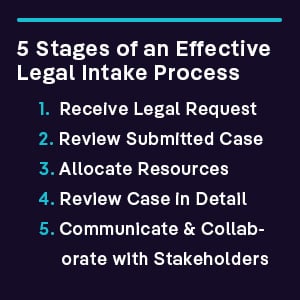If you were asked to nominate a group of professionals for the most effective legal intake processes, you would be forgiven for only putting law firms forward. Client matter intake is – after all – a crucial step before outside attorneys can represent an individual or organization they haven’t worked with before. However, it’s time to start thinking about Legal Intake for in-house legal teams as well! After all, they have clients too.
What is Legal Intake? 
Legal intake process is how a business or law firm assesses a potential client, case, project, or legal request to determine if there are any red flags. For example, a paralegal or an AI algorithm may identify working with a third party as an ethical, legal, relationship-jeopardizing, or reputation-damaging conflict.
A law firm may find during intake that they represent a plaintiff in a case that prevents them from being objective (or appears to be). Or lead attorneys may decide their firm doesn’t have a good chance of winning a case or it would take too many resources (such as time, human, or financial) to pursue.
In-house legal teams also have legal intake processes. Legal requests can come in from across the business, such as to review, annotate, and provide thorough opinions on:
- The approach to acquiring another company and related contracts
- A purchase or lease agreement for a real estate property
- An internal claim that trademarked materials or intellectual copy was misused or stolen by a competitor
- A former employee filed an unfair dismissal claim against the company
- When a class action suit is filed against the company if it causes consumer injury or illness
The volume and velocity of the discussions, written communications, decisions, and next steps related to these matters and others are significant. Digitally transforming legal intake for law firms and corporate legal departments drives efficiency, takes the guesswork out of legal assignments, and alerts legal professionals to any red flags that could be otherwise buried in a repository somewhere.
High-growth and regulated organizations must have effective legal intake processes to triage all legal requests. To prioritize, review, and assign most requests to designated lawyers based on their expertise and experience. For the rest, to reply with instructions that circumstances aren’t a good fit for the organization or that a relationship is too risky to enter into based on existing agreement terms.
How Legal Intake Differs for In-House Counsel
When assessing prospective clients, law firms can take on a client for an individual case or on a retainer basis or decline to represent them. Advances in legal technology have, according to Lexology.com, transformed in-house lawyer roles and created a “law as a service” operating model. Firm attorneys can spend more time with clients than at their laptops, doing administrative work, reviewing agreements and making judgment calls on risk and liability.
Automation of high-volume, time-consuming processes has increased in-house legal operations efficiency. It frees general counsel professionals to advise executives and stakeholders on strategic matters. Corporate legal becomes a catalyst for company profitability instead of a cost center.
Other benefits for in-house legal that provide full management of your legal department function:
- Broader visibility to legal requests and status
- Receiving reliable, consistent instructions
- Elimination of duplicate requests
- Streamline administration and correspondence
- Access data and analytics
Stages of an Effective Legal Intake Process for Legal Departments 
Here are the five phases of a legal request process and how an integrated in-house legal platform can enhance them.
1. Receive the Legal Request
The Manual Process
A lawyer receives a request through Outlook, Slack, Teams, or Google Workplace mail. Many requests come over the phone or through the legal department door. A paralegal reviews the requests to determine who on the legal team is best suited to work on the request to the best of their knowledge. The legal team gets a lot of administrative work heaped on them, often that is outside of their experience set.
The Automated Digital Process
The request is received via Outlook, Google Workspace or the ContractPodAi Cloud dashboard, along with a case intake form from the requestor. The applications are integrated, enabling the automated triage and assignment processes to start immediately. Users can check the dashboard to see the status of existing requests and if any requests are nearing their deadlines. Requests are routed to people with the right expertise and can be most responsive.
The dashboard enables the General Counsel or head of legal operations to view patterns and trends in how long requests take to be actioned and completed by each lawyer.
2. Review the Submitted Query
The Manual Process
The lawyer who is assigned to a case reviews it at their earliest availability. They manually flag any concerning terms and conditions as they carefully read through the case documents.
The whole process is difficult to schedule relative to the constant inflow of new requests and the backlog of complex existing ones. There may be a few calls to the requestor to clarify the intended outcome and other details.
The Automated Digital Process
Interact with a centralized virtual legal assistant (VLA) seamlessly. Through natural language processing (NLP) and AI-powered technology, it provides quick answers to all contract-related queries without needing the user to open contractual documents. The VLA also reviews any request-related documents for potential discrepancies between programming & terms mentioned in your contracts.
3. Allocate Legal Resources
The Manual Process
Requests are received and distributed through email, instant messaging, or whoever is lucky enough to answer the phone or the office door.
The Automated Digital Process
Digital workflows can be set up to route requests to the right attorney based on their workload and expertise. In-house legal can choose to engage and loop in outside legal help as needed. The ContractPodAi Legal Cloud can help to track trends and outcomes around request work cycle times, where requests come from, and the balance of the workload across the team.
4. Review the Request in Detail
The Manual Process
Lawyers continue to work with legal matters by reviewing related matters. As the deeper review takes place, more requests continue to come in. Frustrated, overworked lawyers may be afraid to communicate with the rest of the company for fear of getting more requests on their plate. Extensive research may apply.
The Automated Digital Process
The automated review and anomaly alerts process streamlines the review process. The detailed review process is accelerated, and the legal team can provide strategic advice to the business. Research may be required with automation, though the subject matter expert will have more time to do so because of the automated review. Along the way, there might be “child requests” that evolve out of the main request. These can be associated back to the parent or original request.
5. Communicate and Collaborate with Stakeholders
The Manual Process
Legal professionals and their colleagues from across the business communicate via Microsoft Teams, email, and other channels about any concerns with the case matter. There will likely be several status update checks by the requestor because they have limited visibility into the progress the lawyer is making on the request.
The Automated Digital Process
The ContractPodAi Cloud provides transparency into the status or stage of the request or any notes or questions in the case file. Approvals and signatures can be captured along the way, as well as any subtasks. Employees from across the business can be given visibility and access rights based on their role, or involvement with clients, suppliers, partners, or other parties involved with the request or case.
Automate Your Legal Requests with ContractPodAi
Are you interested in learning more about improving your legal intake process and easing the administrative burden in your in-house legal department? Watch our recorded Legal Intake webinar and demonstration on YouTube, or contact us for a discussion about your unique needs.



